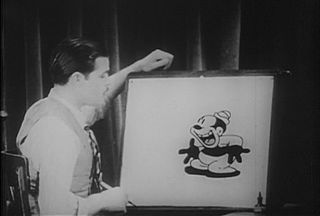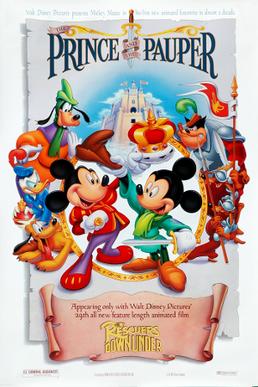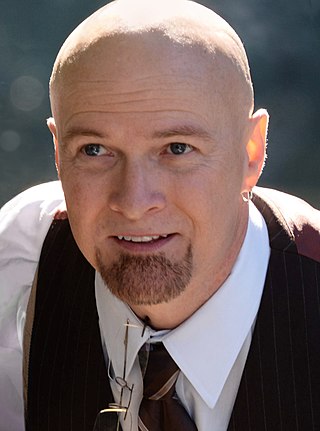Related Research Articles
The golden age of American animation was a period in the history of U.S. animation that began with the popularization of sound cartoons in 1928 and gradually ended from 1957 to 1969, where theatrical animated shorts began losing popularity to the newer medium of television animation since in 1957, produced on cheaper budgets and in a more limited animation style by companies such as Terrytoons, UPA, Paramount Cartoon Studios, Jay Ward Productions, Hanna-Barbera, DePatie-Freleng, Rankin/Bass and Filmation. In artefact, the history of animation became very important in the United States.

Rudolf Carl Ising, Sr. was an American animator best known for collaborating with Hugh Harman to establish the Warner Bros. and MGM Cartoon studios during the early years of the golden age of American animation. In 1940, Ising produced William Hanna and Joseph Barbera's first cartoon, Puss Gets the Boot, a cartoon featuring characters later known as Tom and Jerry.

Runaway Brain is a 1995 American animated comedy horror short film produced by Walt Disney Feature Animation. Featuring Mickey Mouse and Minnie Mouse, the short centers on Mickey attempting to earn money to pay for an anniversary gift for Minnie. He responds to an advertisement to work for Dr. Frankenollie, but finds that the doctor is looking for a donor to switch brains with the monster he created. Featuring animation by animator Andreas Deja, it was first released in 1995 attached to North American theatrical showings of A Kid in King Arthur's Court and in 1996 attached to international theatrical showings of A Goofy Movie. It would be the final original Mickey Mouse theatrical animated short until Get a Horse! in 2013.
Richard James Lundy was an American animator and film director who worked at several animation studios including The Walt Disney Company, MGM, and Hanna-Barbera. Lundy was a pioneer of personality animation and is best remembered as one of the creators of Donald Duck. Throughout his career he worked as a primary animator on at least 60 films, both short and feature-length, and directed 51 shorts.
Wang Film Productions Co., Ltd. is one of the oldest and most prolific Taiwanese-American animation studios since 1978. The company, based in Xindian, Taipei and Los Angeles, California, has done traditional hand-drawn 2D animation/ink and paint for various TV shows and films for studios across North America, Europe and Asia-Pacific.
John Ryan Kinney was an American animator, director and producer of animated shorts. Kinney is the older brother of fellow Disney animator Dick Kinney.

Roger Allers is an American film director, screenwriter, animator, storyboard artist, and playwright. He is best known for co-directing Disney's The Lion King (1994), the highest-grossing traditionally animated film of all time, and for writing the Broadway adaptation of the same name. He also directed Sony Pictures Animation's first feature-length animated film, Open Season (2006) and the animated adaptation of The Prophet.
Preston Erwin Blair was an American character animator, best remembered for his work at Walt Disney Productions and the Metro-Goldwyn-Mayer cartoon studio.

The Metro-Goldwyn-Mayer cartoon studio was an American animation studio operated by Metro-Goldwyn-Mayer (MGM) during the Golden Age of American animation. Active from 1937 until 1957, the studio was responsible for producing animated shorts to accompany MGM feature films in Loew's Theaters, which included popular cartoon characters Tom, Jerry, Droopy, Butch, Spike, Tyke, and Barney Bear.
Donovan Ryan Cook III is an American filmmaker, animator, cartoonist, director and producer, best known for creating, directing and producing the animated series 2 Stupid Dogs and directing the Disney animated features Return to Never Land and Mickey, Donald, Goofy: The Three Musketeers.
Charles August "Nick" Nichols was an American animator and film director, who worked in animation for over 50 years at Walt Disney Animation Studios and Hanna-Barbera. At Disney, he worked on various short subjects and films from the 1940s into the 1950s, including the Academy Award-winning short Toot, Whistle, Plunk and Boom (1953). Nichols co-directed Charlotte's Web (1973) while at Hanna-Barbera.

The Prince and the Pauper is a 1990 American animated comedy action-adventure featurette produced by Walt Disney Feature Animation and directed by George Scribner. Featuring the voice of Wayne Allwine as Mickey Mouse, it is inspired by Mark Twain's 1881 novel of the same name. It was Disney's final use of the traditional ink-and-paint and camera process for a theatrical product, before the CAPS digital-ink-and-paint process rendered the traditional techniques and equipment obsolete. Some objects, such as the carriage, were created on computers before being printed out on paper and photocopied onto animation cels. The animation was given a watercolor look and based on Disney's style from the late 30s, influenced by Fred Moore.

Rick Calabash is an American film and television producer, writer and director, particularly of animated family films.

Mickey's PhilharMagic is a 4D film attraction found at several Disney theme parks around the world, including Magic Kingdom theme park at the Walt Disney World Resort, Hong Kong Disneyland, Tokyo Disneyland, Disneyland Park (Paris), and Disney California Adventure. The film was directed by George Scribner, who also directed Disney's 1988 animated film Oliver & Company. Mickey's PhilharMagic is a 12-minute-long show featuring 3D effects, scents, and water, as well as a number of characters from Disney movies. It is shown on the largest purpose-built 3D screen ever made, at 150 feet wide.
Carole Holliday is an American animator, storyboard artist, director, and founder of Crowded Metro Films. She initially wanted to be a theatre actress, but went into animation instead to avoid compromising her Christian faith. She graduated from California Institute of the Arts with a BFA in animation. Combining her love of theatre and drawing, she found a passion in story boarding. Holliday worked as an animation assistant on several films, such as Oliver and Company (1988) and The Little Mermaid (1989), before she began a career in story boarding on A Goofy Movie (1995). She was also a story artist on the DreamWorks feature film The Prince of Egypt (1998) and Disney's feature films Tarzan (1999) and The Jungle Book 2. Additionally, she worked as a character design supervisor on the Disney short John Henry (2000). In 2004, she moved up to directing Donald’s Gift with DisneyToon Studios as part of Mickey's Twice Upon a Christmas
Willie Ito is an American animator. He worked for Walt Disney Animation Studios in the 1950s, moved to Warner Bros. Cartoons and Hanna-Barbera Productions as a character designer, and later returned to Disney.
Events in 1935 in animation.
Events in 1913 in animation.
Events in 1912 in animation.
Events in 1911 in animation.
References
- ↑ "Happily Ever After Hours | Director and Filmmaker George Scribner | The Walt Disney Family Museum". www.waltdisney.org. Retrieved 2023-08-15.
- ↑ Herrera, Miroslava (2022-07-12). "George Scribner: Portraits of Affection". El Faro | Canal de Panamá. Retrieved 2023-08-15.